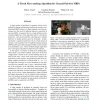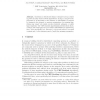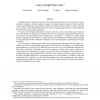157 search results - page 23 / 32 » Randomized Algorithms for Minimum Distance Localization |
CVPR
2012
IEEE
11 years 10 months ago
2012
IEEE
A large number of problems in computer vision can be modeled as energy minimization problems in a markov random field (MRF) framework. Many methods have been developed over the y...
CORR
2010
Springer
13 years 6 months ago
2010
Springer
We give an algorithm for solving the exact Shortest Vector Problem in n-dimensional lattices, in any norm, in deterministic 2O(n) time (and space), given poly(n)-sized advice that...
DCOSS
2009
Springer
14 years 2 months ago
2009
Springer
Abstract. Gradients are distributed distance estimates used as a building block in many sensor network applications. In large or long-lived deployments, it is important for the est...
SODA
2007
ACM
13 years 9 months ago
2007
ACM
Random geometric graphs have been one of the fundamental models for reasoning about wireless networks: one places n points at random in a region of the plane (typically a square o...
TSMC
1998
13 years 7 months ago
1998
—Consider the problem of a robot (learning mechanism or algorithm) attempting to locate a point on a line. The mechanism interacts with a random environment which essentially inf...



